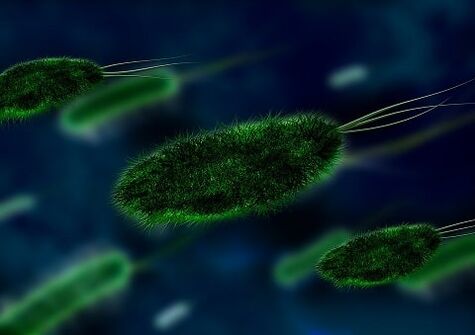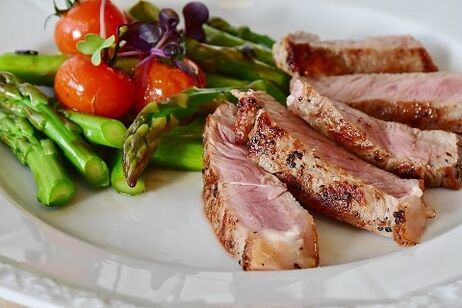To understand nutrition in gastritis, you must first understand its causes. The most common cause is the bacterium Helicobacter pylori. Due to its structure, this microbe penetrates the protective barriers in the stomach, attaches to epithelial cells and damages them with the development of chronic gastritis.
Chronic gastritis is one of the most common stomach diseases. It represents 85% of all lesions of this organ.

Has gastritis and allergic nature with food allergies to dairy products, eggs, chocolate and more.
The gastrointestinal tract is an inseparable system and if one link in this chain is damaged, there is a disorder in all the others. Therefore, chronic gastritis is often associated with malfunction of the liver, intestines, pancreas.
But the nutritional factor for the appearance of gastritis today is not assigned such a big role. However, gastritis can be caused by:
- Eating disorders (irregular, hasty meals with insufficient chewing of food);
- Eating poor quality food;
- Abuse of very spicy foods (pepper, adjika, mustard, vinegar, etc. ), especially if such food is not common for you;
- Marinades, smoked meats, highly fried dishes with their frequent use;
- Abuse of very hot or very cold foods;
- Alcohol abuse.
Of course, all these factors must be taken into account when eating for gastritis.
Iron deficiency can also lead to gastritis. You can read more about nutrition in anemia in the article at the link.
Nutrition in gastritis of various forms

Nutrition in gastritis will depend on its form. There is gastritis with high acidity and gastritis with low acidity.
The acidity of the stomach is determined by the amount of hydrochloric acid produced. If there is a lot, the acidity increases, it decreases a little. Acidity is measured using a pH meter during fibrogastroduodenoscopy. But there is a small nuance here: the test is performed within 20-30 minutes and hydrochloric acid is produced in our country constantly. And the introduction of a tube into the stomach is a stimulating factor for the production of hydrochloric acid. In order to more accurately assess gastritis with increased or decreased acidity, it is necessary to perform daily monitoring of hydrochloric acid production.
| Product | Use |
| oil for gastritis | 5-10g per day, if normally tolerated by the patient, then you can |
| almond milk for gastritis | also watch individually |
| milk for gastritis | can be medium oily |
| coconut milk, oil for gastritis | individually |
| bread for gastritis | possible, unwanted wheat |
| salmon in gastritis | limited, 40-60g per day |
| bulgur with gastritis | unwanted wheat |
| avocado in gastritis | limited, 30g per day |
| vegetables in gastritis | individually |
| mackerel in gastritis | limited, 40-60g per day |
| trout with gastritis | limited, 40-60g per day |
Today, nutrition in gastritis must be personalized, taking into account the individual tolerance of the products. Wheat and fat are limited. And that's all. We also limit coffee, alcohol, nicotine. One should individually avoid those foods that cause him pain and discomfort.
There are general principles of nutrition in gastritis:
- Methods of cooking - optimal cooking, stewing, baking in a sleeve without the formation of very fried crust. You must cook in a non-stick pan or use non-stick paper. Fats in the form of butter or coconut oil should be added to ready meals.
- The food should also be mechanically sparing - cook puree soups or with chopped foods.
- If you want to explore in more detail the issue of compiling diets for various diseases, you can also attend courses in nutrition without medical education.

Nutrition in gastritis with high acidity:
- Exclude from the diet foods that stimulate the production of hydrochloric acid and irritate the mucous membranes - strong broths (mushrooms, meat, fish), smoked meats, fried foods, spices, pickles, pickles, mushrooms, coffee, strong tea, alcoholic beverages, carbonatedwater, fresh butter, bakery products.
- Recommended products for gastritis with high acidity: Boiled meat and fish, soft-boiled eggs, pasta, cereals, stale white bread, milk soups. The vegetables are stewed or cooked in mashed potatoes and steamed souffle. Sour, mousses, jellies, baked apples, cocoa with milk, weak tea are also allowed.
Nutrition in gastritis with low acidity:
- Recommended foods: low-fat broth soup, low-fat meat (even fried, but without hard crust), low-fat fish, all fresh and not too sour fermented dairy products, stale bread of various varieties, biscuits, vegetables and fruits - both cooked andin the form of cheese, milk, eggs - raw and omelets, various well-cooked cereals, fruit and vegetable juices, butter, tea, coffee, cocoa.
To make it clearer, in the table I will give a list of permitted foods for gastritis:
What is acceptable in the diet for gastritis with high acidity?
| Fruits: |
| Baked apples / pears, bananas, oranges, persimmon, kiwi, avocado |
| Vegetables: |
| Chinese cabbage, carrots, beets, zucchini, eggplant, squash, cucumber, black pepper, celery, tomato, potatoes |
| Cereals: |
| Wild rice, buckwheat, whole grain oatmeal, quinoa, millet; flour - almond, rice, amaranth, buckwheat, coconut |
| Meat: |
| Rabbit, turkey, chicken, quail, beef |
| Fish: |
| Low fat (sea bream, pelengas, pike, hake, etc. ) and fats (salmon, salmon, sea bass, trout, sea bass, etc. ) |
| Seafood |
| Bread, pasta: |
| Rice or buckwheat bread, gluten-free bread, rice or buckwheat noodles, white stale bread, white bread croutons |
| Oils, nuts, seeds: |
| Olive, flaxseed, coconut, avocado, sesame, pumpkin oil pumpkin seeds, sunflower seeds |
| Dairy products: |
| Hard cheese, butter, almond milk, rice milk, coconut milk |
| Eggs: |
| Chicken, quail - soft boiled, omelet |
What is acceptable in the diet for gastritis with low acidity?
| Fruits: |
| Various raw fruits and baked |
| Vegetables: |
| White cabbage and other types of cabbage, carrots, beets, zucchini, eggplant, pumpkin, cucumber, pepper, celery, tomatoes, potatoes, radishes, daikon, leafy vegetables, onions, parsley, dill |
| Cereals: |
| Wild rice, buckwheat, whole grain oatmeal, quinoa, millet; |
| flour - almond, rice, amaranth, buckwheat, coconut |
| Meat: |
| Rabbit, turkey, chicken, quail, beef, veal |
| Fish: |
| Low fat (sea bream, pelengas, pike, hake, etc. ) and fats (salmon, salmon, sea bass, trout, sea bass, mackerel, etc. ) |
| Seafood |
| Bread, pasta: |
| Bread with rice or buckwheat, gluten-free bread, noodles with rice or buckwheat, various types of stale bread |
| Oils, nuts, seeds: |
| Olive, flaxseed, coconut, avocado oil, sesame, pumpkin |
| Walnuts, almonds, cedar, pistachios, pecans, Brazilian; pumpkin seeds, sunflower seeds |
| Dairy products: |
| Milk, cottage cheese in the form of casserole / cupcakes, kefir, yoghurt, fermented baked milk, yoghurt, hard cheeses, butter, almond milk, rice milk, coconut milk |
| Eggs: |
| Chicken, quail |
What is the diet for gastritis?
- Meals 5 times a day. Three main meals and two snacks.
- Methods of cooking - cooking, stewing, steaming, baking in the sleeve, sous vide. Do not bake until golden brown. Fry in a pan with a non-stick coating or baking parchment.
- Cooking and roasting on a fire are unhealthy ways.
- Drink water 30 minutes before meals or 40 minutes after.
- Nuts (excluding pine nuts and pistachios) must be soaked in water for at least three hours before use or overnight, then dried and eaten.
- Oily fish should be included in the diet 1-2 times a week.
- Eggs can be included in the diet 3-4 times a week.
- 80% of vegetables in gastritis with high acidity should be in the diet after heat treatment. In gastritis with low acidity 50% of raw vegetables and 50% of vegetables after heat treatment.
- The first dishes are prepared in the second or third broth.
Approximate diet for gastritis
Breakfast 7. 00
- Omelet of 2-3 eggs with vegetables.
- Oatmeal in almond milk with banana and nuts.
- Buckwheat porridge (+ 5 g. Butter) with steamed turkey cutlet, vegetable salad with olive oil.
- Boiled wild rice (+ 5g butter) with boiled chicken fillet, vegetable salad with linseed oil.
- Boiled quinoa with vegetables (+ 5g butter), stewed rabbit.
Snack 10. 00
- Baked apple with walnuts.
- Baked pear with almonds.
Lunch 13. 00
- Pumpkin puree soup, boiled turkey fillet.
- Bulgur porridge (+ 5 g coconut oil), stewed beef, boiled beets.
- Buckwheat porridge (+ 5g coconut oil), roasted oily fish, zucchini caviar.
- Mashed potatoes with milk and butter, steamed chicken cutlet, vegetable stew with pumpkin and vegetables.
- Potato soup with grits in chicken broth, rice bread, boiled chicken.
Snack 16. 00
- Almond milk.
- Natural yogurt.
- Casserole with cottage cheese.
- Steamed pancakes.
- Kefir 1%.
Dinner 19. 00
- Steamed low-fat fish with stewed vegetables.
- Steamed fish cutlet with vegetable casserole.
- Stewed rabbit with vegetable stew.
- Salad of avocado and Chinese cabbage, cucumbers and seafood.
- Rice with seafood and roasted vegetables.
How to eat with gastritis? Summarize.
- A well-established diagnosis is required - gastritis with high or low acidity in you. There is also atrophic gastritis. Nutrition in gastritis depends on its form.
- Eating for gastritis of any form five times a day. Eating more often is not necessary, but three meals a day can worsen the symptoms of gastritis.
- Cooking plays a key role. You can't fry food until very golden brown, even for healthy people.
- The diet for gastritis during exacerbation will be different from that described above. Follow the recommendations your doctor will give you during an exacerbation.
- With the help of nutrition, chronic gastritis can be constantly maintained in remission.































